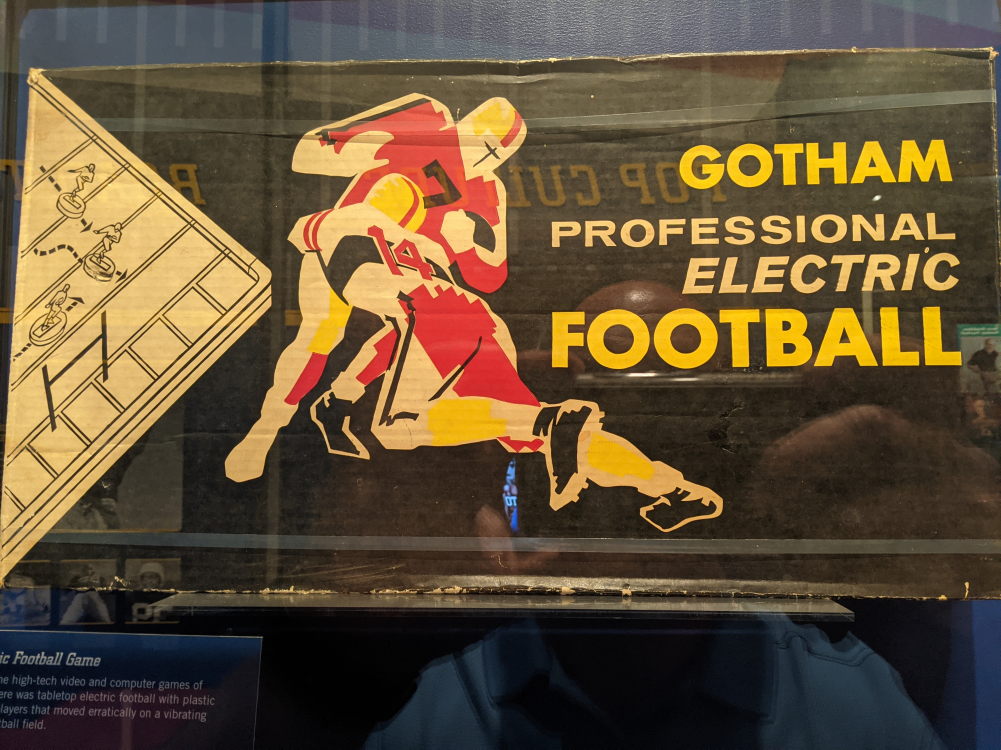In this edition, Chris LeMay founder of the National Electric Football Game Museum visits the Pigpen to discuss the history of one of the most iconic football inspired games of all time, miniature, vibrating game board football. Chris shares where the game come from, where it is now and all the ins and outs along the way, as well as where and how one can get involved with enjoying the game in today's digital age.
National Electric Football Game Museum
The Good Vibrations of the Electric Football Game
If you are a person born before 1990 in the United States I am sure at one point or another that you came across a friend or relative that had a vibrating board game called electric football. The pageantry and motion of these miniature players that you could hold in your hand was a football fan youths dream. Our guest Chris LeMay enjoyed the game so much that even in adulthood he reconnected to the game of his childhod and not only started playing the game again, but started collected the boards, players and accessories building the collection into what he hopes some day will be a brick and mortar museum where folks can enjoy the game, its history and even play on both modern and vintage game boards.

Photo taken at the Pro Football Hall of Fame's exhibit on football insprired activities.
Electric Football Museum
According to Chris the game started in 1949 by a toy and game manufacturer called Tudor Metal Products,. This New York based company according to the Tudor Games website started in 1929 by a man named Elmer Sas. Elmer battled to keep his company afloat through the Depression era and shortly after that his son Norman took over. It was Norman Sas that invented the game when he modified a couple of vibrating metal board games inspired by horse and auto racing to entail the graphics of a football field. The game was crude by today's standards but it grew in popularity quickly. About five years later in 1954 a second manufacturer, Gotham Games made their own version to compete with Tudor. It stayed this way for about 15 years until in the early 1970's there were four different companies manufacturing and selling their own versions of the popular activity when Coleco and Monroe joined the fray.
Chris tells us that with the advent of electronics in the mid to late 1970's that the vibrating football games suffered hard ships as bankruptcy and discontinuation of the games were seen at some point by all four topy manufacturers occurred. Tudor survived even though it had been bought and sold a couple of times through the years. Norman Sas sold Tudor to Superior Toys at one point and then they ran the product for years until they were bought out and went out of business in the early 1990's. A new Competitor tried promoting a similar product called ABC Monday Night, but they were soon shot down for name and rights infringements by ABC and the NFL. Michael Landsmen the former president of Superior Toys bought the rights to the game andafter a two year absence, the vibrating table top brand of football was produced new once more. Landsmen eventually sold Tudor Games to its current owner Doug Strohm and the company to this day is still making and selling the game under the Tudor name. There survival is based on the great loyalty of their customers and the licensing of all of the NFL teams. The game today has social media groups with members in the thousands and tournaments and leagues are being conducted year round all over the country by enthusiasts.

More of Chris Lemay's game board collection set aside for the museum. Courtesy Chris LeMay.
The attraction of holding the figures in your hands, being able to control their very moves and devise a strategy to overcome your opponent are many of the same elements that make the real game of football so appealing to so many. We invite you to check out the National Electric Football Game Museum website and Tudor games site as well to learn more about this great game and how you can own a set and get involved with others that share the same passion.
Here are a couple of great videos, the first is a 1971 Tudor Games commmercial and the second an interview with current Tudor Games CEO Doug Strohm by Decades.com on the history of the game.
The Photo Credits
The picture in the banner above is courtesy of Chris LeMay and his NEFGM .com website. It is of a small portion of Chris' awesome collection of games set aside for the museum. Also the Gotham game photo was taken at the Pro Football Hall of Fame in Canton, Ohio of one of the manufacturers who made a version of the game. The Pro Football Hall of Fame needs to be a bucket list place to visit so that you can enjoy seeing football history in person. Don't forget about our friend Doug Strohm and his Tudor Games to get supplied with game sets and more.


